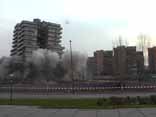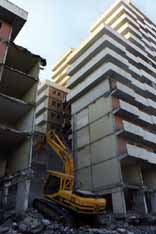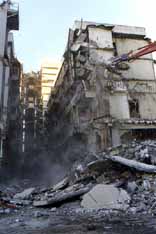|
|
| EVOLVING LANDSCAPES/Demolition: a half-way transformation by Alessandro Bagella |
|
|
| EVOLVING LANDSCAPES/Demolition: a half-way transformation by Alessandro Bagella |
| [in italiano] |  Aerial view of Scampia, Napoli (photo arch. Paolo De Stefano; concessione aeronautica militare R.G.S. n. 22 del 15/02/2000). Indeed, the breakdown of a residential building provokes an emotional response in its audience. Although reactions vary according to the spectators, nobody can interact with the event, which can only be suffered and watched aside/standing still. In the United States, demolition has been used as a town planning device for a few decades. As expecting future changes generally helps to skip eventual shocks, the explosion of one’s own house can even turn into collective enthusiasm, up to be sublimed by spectacular additions of lights, sounds, etc. In Italy, on the contrary, demolition means making up for building abuses, landscape destructions and even social disasters, as outlined in the following case study: Scampia is the name of the suburb in the hosting city of Naples and 'Sails' is the nickname for the buildings. |
[27oct2000] | ||
 Videoclip (AVI 1,7MB). |
Research into Social Housing has not yet managed to overcome serial and modular repetition, which remains the basic principle of its kind for urban and architectural design. The
'Sails' buildings stand out in context because of their particular typology, structure and aesthetics: they are an exemplary representation of a rare attempt at experimentation and, at least within the Italian history of contemporary architecture, their honourable mention is fully deserved. The prevalence of certain 'social typology' exposed their inhabitants to such unbearable deterioration both inside and outside the living space, that the buildings have been condemned from future residential use. At the same time, their architectural typology has inspired many other social dwellings without similar repercussions (even Montecarlo shows terrace roofed edifices served by a corridor…). |
  Under construction. |
||
  Temporary Landscapes. |
 The "Sails". The structure, designed by engineer R. Morandi, proved its durability in the first demolition attempt, for which three different tries were needed to finally pull the building down, after a year long delay. An 'American result' would in fact require greater quantities of explosives to effectively damage the surrounding built-up area, which would make the previous phase of mechanical demolition inevitable. Nevertheless, the rigidity of the reinforced concrete alveolar structure would imply a complex and expensive restoration and would therefore urge towards demolition and rebuilding. |
|||
| Yet demolition does not provide any substantial contribution to the development of Scampia. By eliminating the evident delapidation is not a remedy for the dominant mentalities! How can common, founded behaviours be modified if the inhabitants are excluded from the transformation of their own environment? The flash time of a detonation provides but an illusion for life time mutations. Children are the only reality that we need to work on, for indeed, no matter how well we manage the present, they essentially are the ones who can change the future. Alessandro Bagella a.bagella@worldonline.it |
||||
 "Work in progress". |
Alessandro Bagella
was born in Arezzo (Italy) in 1970. Student of Architecture at the University of Florence, spent the last year in Naples, living nearby the site of survey. His final thesis, "Catalytic borders", inquires into potentials and contradictions of infrastructures: dynamic perception of space and functional conversion of underviaducts being main topics of the project. In 1998 was selected for the international workshops organised by the "Netherlands Architecture Institute" (Rotterdam) and "the Berlage Institute" (Amsterdam), held by Lebbeus Woods and Steven Holl respectively; the former ended up with a collective exhibition at the NAI and the publication by NAI publisher. During the "VII seminar on architecture and urban culture" (Camerino, 1997), presented the project "vertical squares", a public space meant to be freely modifiable by citizens (published on "Metamorfosi", 38, 1998). |